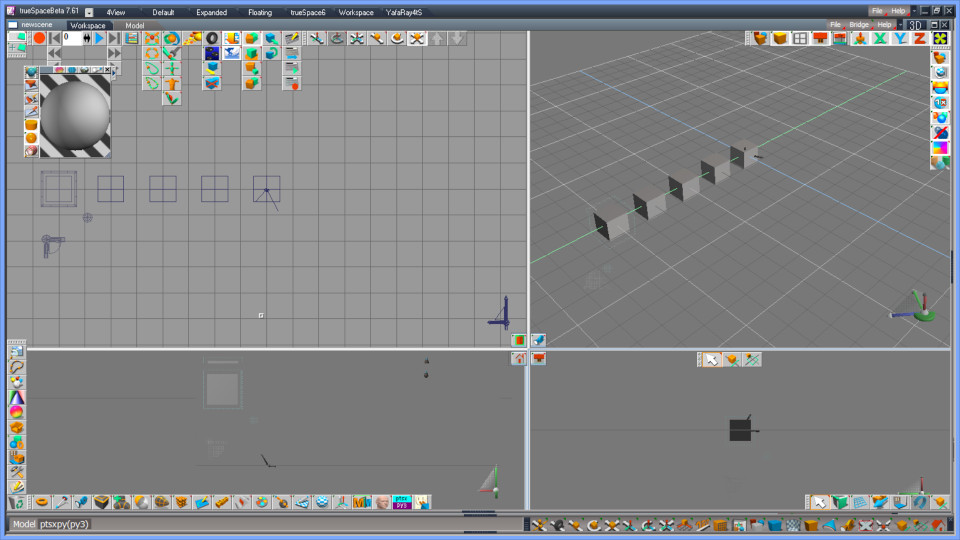Comment
Code: Select all
# This whole line is comment, and ignored by Python interpreter.
import ptsxpy as p # from the sharp sign to the new line is also comment
# But the sentence written before (i.e. left side of) the sharp sign is interpreted by Python.
In a Python script, the indentation level (i.e. blank preceding to each line) is significant. The author uses 4 blank spaces for indentation in all sample scripts according to the official documents distributed by python.org: "PEP 8 -- Style Guide for Python Code" .
Code: Select all
#------------------------------
# Crete and move some cubes.
#------------------------------
import ptsxpy as p
x = 0.
for i in range( 5 ):
print( "i=", i )
cb1 = p.CreateCube( 2 , 1., 1., 1. )
p.SceneAddObject( cb1, e_tsxFALSE )
loc = Vec3f( x, 0., 0. )
print( "loc=", loc.prt() )
p.GNodeSetLocation( cb1, loc.p )
x += 2.
p.SceneDraw()

As show in example above, a for-loop does not have any parenthesis, have a colon ":" and indentation for all lines included in the loop instead. In case of nesting (another loop in the loop), we need to add 4 spaces to each line in the inner loop.
Types and Literals
Types which you minimally need to know for ptsxpy are;
- int ---- an integer value. e.g. -123
- float ---- a (64 bit) floating point value. e.g. 3.14
- string ---- a quoted string that consists of none or more characters. e.g. "abc"
- tuple ---- an object parenthesized by round brackets and it consists of none or more comma-separated elements. e.g. (123, "ab", 0.1 )
- list ---- an object parenthesized by square brackets and it consists of none or more comma-separated elements. e.g. [123, "ab", 0.1 ]
- dict ---- an object parenthesized by curly brackets and it consists of none or more comma-separated pair of key:value elements. e.g. {"a":123, "3":"B"}
Functions, mutable and immutable
In python, you can use functions in order to package specific sequences as subroutines as with other programming languages. To declare a function, write "def" followed by white blank(s), a function name, parameters in parenthesis, and colon ":". The code belonging to the function has one unit of indentation.
Code: Select all
def func1( a, b ):
print( "a=", a, ", b=", b )
a = a + 1
return a * b
def func2( lst1 ):
for i in range( 7, 10 ): # i.e. loop for 7, 8, 9
lst1.append( i ) # add a value to a list as the last element
c = 5
d = 6
e = func1( c, d ) + func1( 2, 3 ) # assign (5+1)*6 + (2+1)*3 to a variable e
print( "c=", c, ", d=", d, ", e=", e )
l1 = [] # an empty list
func2( l1 )
print( "l1=", l1 )
Code: Select all
Executing [.... xxxxx.py]
a= 5 , b= 6
a= 2 , b= 3
c= 5 , d= 6 , e= 45
l1= [7, 8, 9]
.... xxxxx.py ended.----------
The ptsxpy in its early versions (till about y2017) had a specification where it uses list objects for parameter to API functions, but the author changed so that user Python scripts directly uses C++ pointer using predefined classes (like Vec3f) because the older spec is bit difficult to understand and far apart from the tsxAPI's spec.
